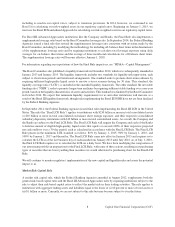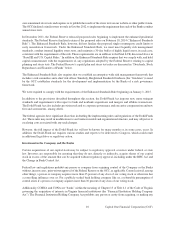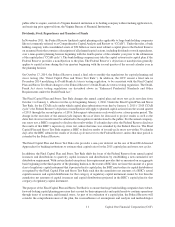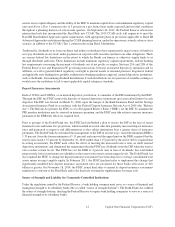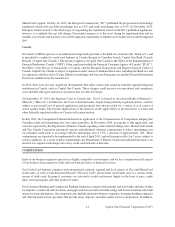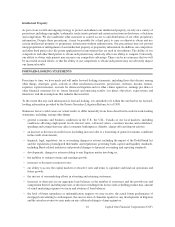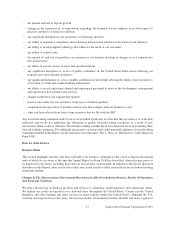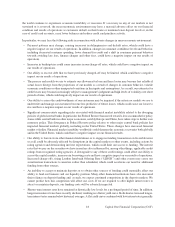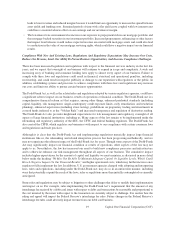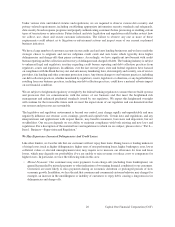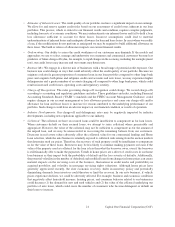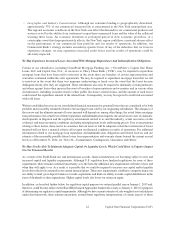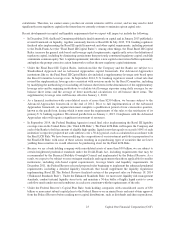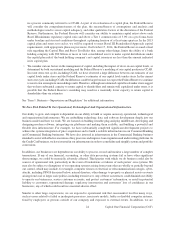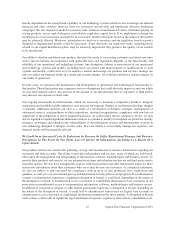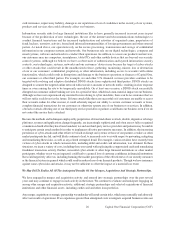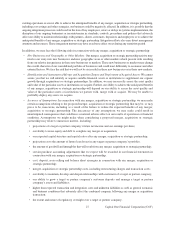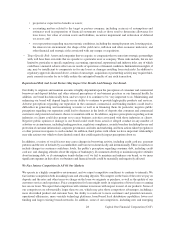Capital One 2014 Annual Report Download - page 40
Download and view the complete annual report
Please find page 40 of the 2014 Capital One annual report below. You can navigate through the pages in the report by either clicking on the pages listed below, or by using the keyword search tool below to find specific information within the annual report.the world continue to experience economic instability or recession. If a recovery in any of our markets is not
sustained or is reversed, the macroeconomic environment may have a material adverse effect on our financial
condition and results of operations as customers default on their loans or maintain lower deposit levels or, in the
case of credit card accounts, carry lower balances and reduce credit card purchase activity.
In particular, we may face the following risks in connection with adverse changes in macroeconomic environment:
• Payment patterns may change, causing increases in delinquencies and default rates, which could have a
negative impact on our results of operations. In addition, changes in consumer confidence levels and behavior,
including decreased consumer spending, lower demand for credit and a shift in consumer payment behavior
towards avoiding late fees, finance charges and other fees, could have a negative impact on our results of
operations.
• Increases in bankruptcies could cause increases in our charge-off rates, which could have a negative impact on
our results of operations.
• Our ability to recover debt that we have previously charged-off may be limited, which could have a negative
impact on our results of operations.
• The process and models we use to estimate our allowance for loan and lease losses may become less reliable if
actual losses diverge from the projections of our models as a result of changes in customer behavior, volatile
economic conditions or other unexpected variations in key inputs and assumptions. As a result, our estimates for
credit losses may become increasingly subject to management’s judgment and high levels of volatility over short
periods of time, which could negatively impact on our results of operations.
• Our ability to assess the creditworthiness of our customers may be impaired if the criteria or models we use to
underwrite and manage our customers become less predictive of future losses, which could cause our losses to
rise and have a negative impact on our results of operations.
• Significant concern exists regarding risks associated with financial market instability related to the diverging
policies of global central banks. In particular, the Federal Reserve has moved toward a less accommodative policy
stance while central banks in other major economies, notably Europe and China, have taken steps to further ease
monetary policy. This divergence in Federal Reserve policy relative to other major central bank policies has
impacted financial markets globally, including in the United States. These changes have increased financial
market volatility. Financial market instability worldwide could threaten the economic recoveries both globally
and in the United States, which could have a negative impact on our financial results.
• Our ability to borrow from other financial institutions or to engage in funding transactions on favorable terms
or at all could be adversely affected by disruptions in the capital markets or other events, including actions by
rating agencies and deteriorating investor expectations, which could limit our access to funding. The interest
rates that we pay on the securities we have issued are also influenced by, among other things, applicable credit
ratings from recognized rating agencies. A downgrade to any of these credit ratings could affect our ability to
access the capital markets, increase our borrowing costs and have a negative impact on our results of operations.
Increased charge-offs, rising London Interbank Offering Rate (“LIBOR”) and other events may cause our
securitization transactions to amortize earlier than scheduled, which could accelerate our need for additional
funding from other sources.
• An inability to accept or maintain deposits or to obtain other sources of funding could materially affect our
ability to fund our business and our liquidity position. Many other financial institutions have also increased
their reliance on deposit funding and, as such, we expect continued competition in the deposit markets. We
cannot predict how this competition will affect our costs. If we are required to offer higher interest rates to
attract or maintain deposits, our funding costs will be adversely impacted.
• Shorter-term interest rates have remained at historically low levels for a prolonged period of time. In addition,
longer-term interest rates have recently declined, resulting in a flatter yield curve. Both shorter-term and longer-
term interest rates remain below historical averages. A flat yield curve combined with low interest rates generally
18 Capital One Financial Corporation (COF)


